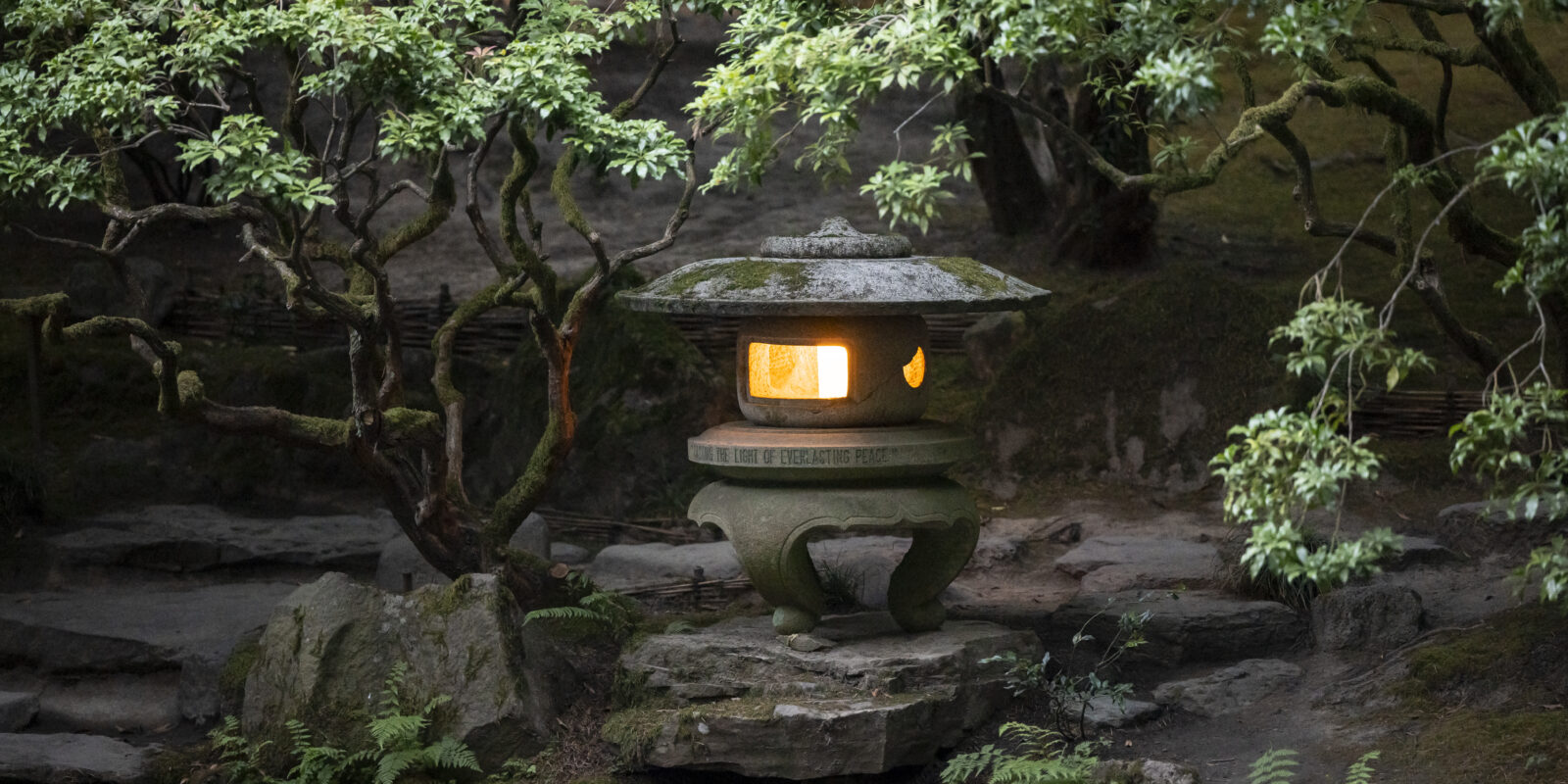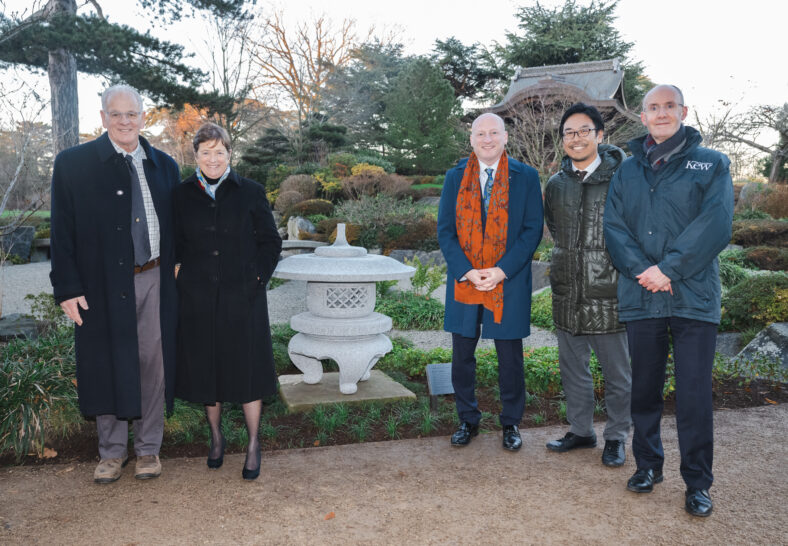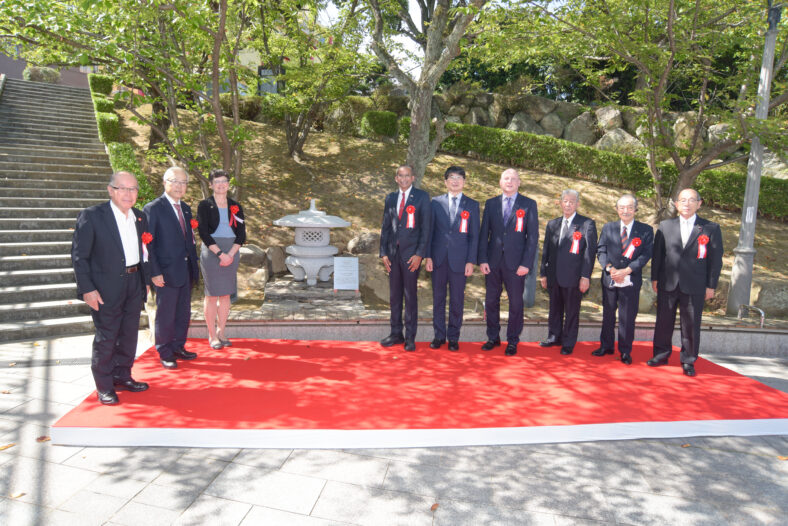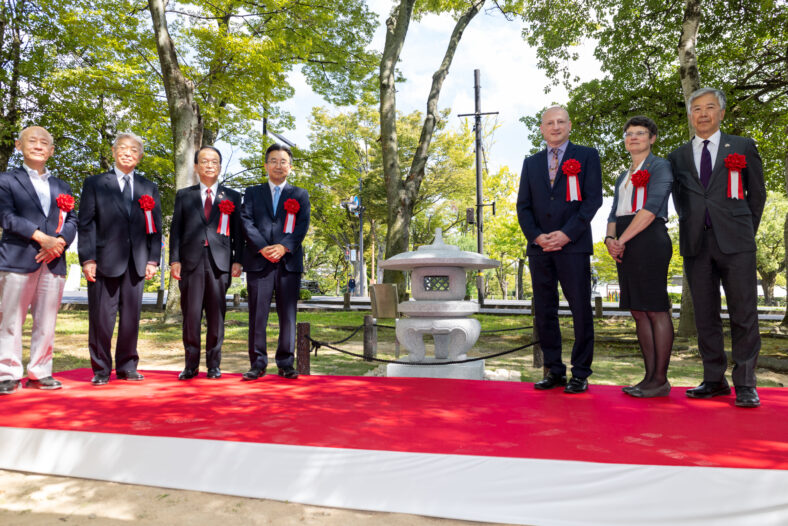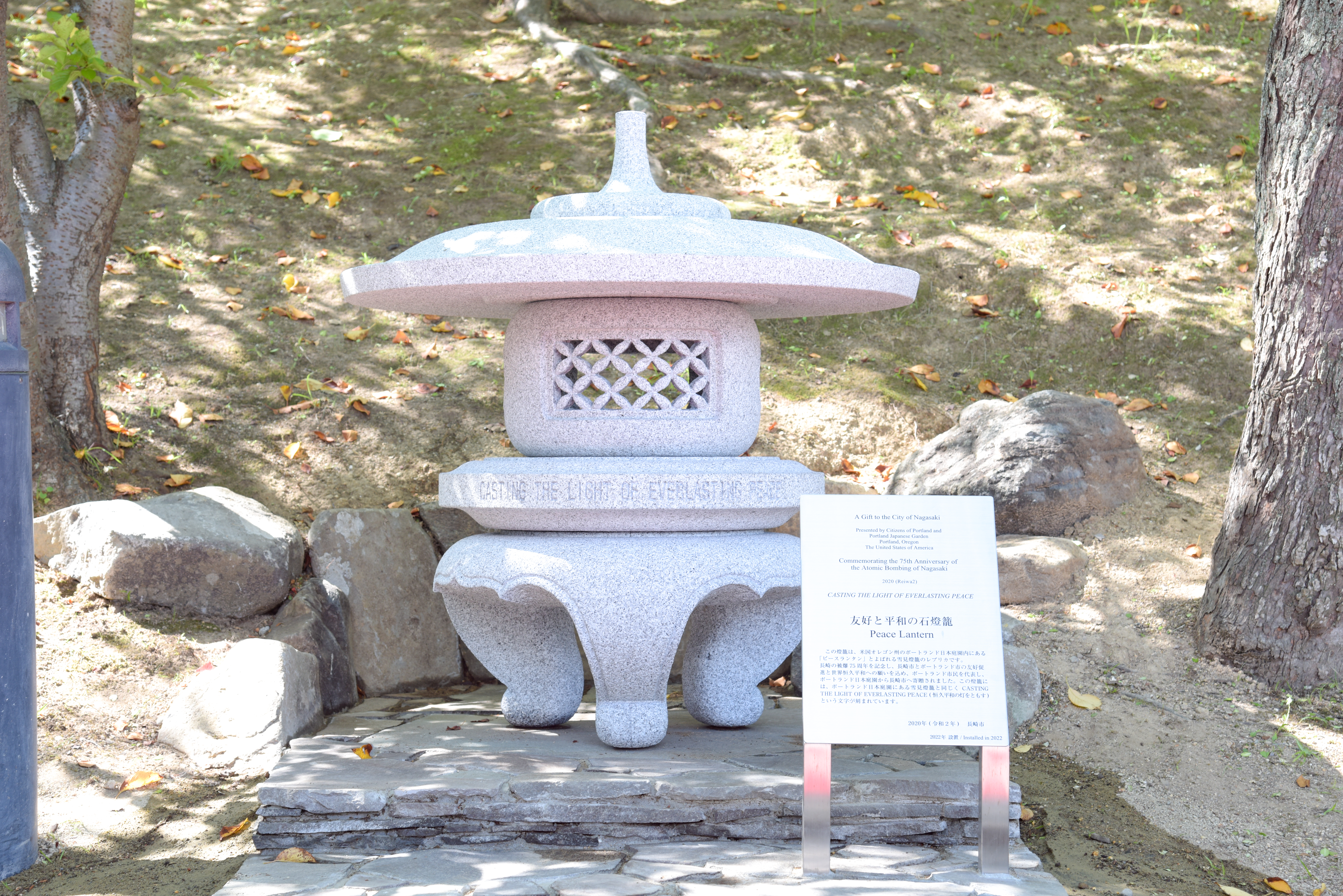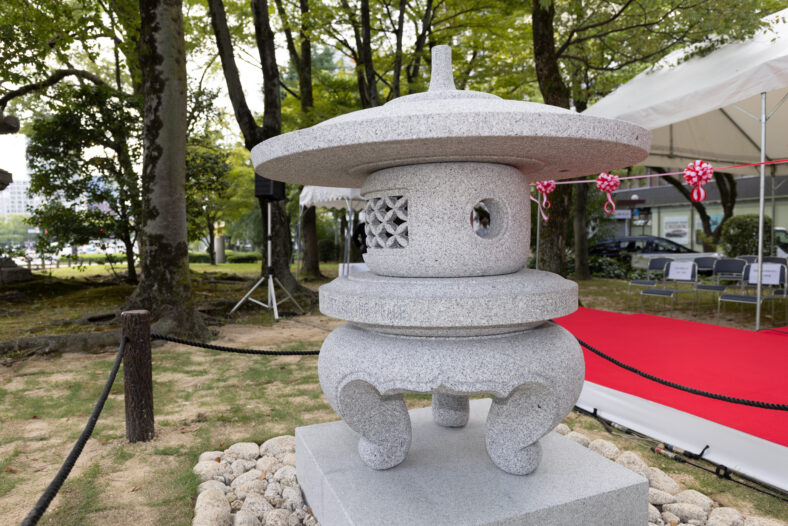This article is also available as a pdf.
We may never know who created the first stone lantern or the precise form that it took, but surely it must have been installed where humankind traversed and in a place in want of illumination. The world in which they were developed is a difficult one to imagine, a time where shadows and dark recesses pervaded. However, a lantern containing a candle or lamp filled with fats and oils was never intended to banish the dark. Instead, the light the ishi-doro (stone lantern) cast provided a means through even blinding pitch-black, a way to make the places and people we needed, discoverable.
Believed to have been introduced in the sixth century by the Chinese, stone lanterns became a ubiquitous presence throughout ancient Japan. As with so many other tools and instruments, the Japanese rendered its stone lanterns into increasingly intricate art. What may have been condemned to utilitarian and unpleasing aesthetics were made beautiful, because they could be. It is no wonder they remain with us today among shrines and temples and, yes, gardens.
Portland Japanese Garden, celebrated as the most beautiful and authentic Japanese garden outside of Japan, has been fortunate to have received donations of many fine stone lanterns, each of which contribute to the rich aesthetic texture of the landscape. Although they are rarely lit, the ishi-doro here still beckon us towards them as though the warmth of the flame still lingers. The magnetism of the lanterns here can sometimes be attributed to unmistakable visual splendor, such as the massive, two-ton Sapporo Pagoda Lantern, a gift from Portland’s sister city of Sapporo. Sometimes a lantern compels us into its space because it takes a surprising shape, such as the Koto-ji Lantern, a gift from the city of Kanazawa, resembling the bridge of a koto (harp) with one leg on land in the other in stream.
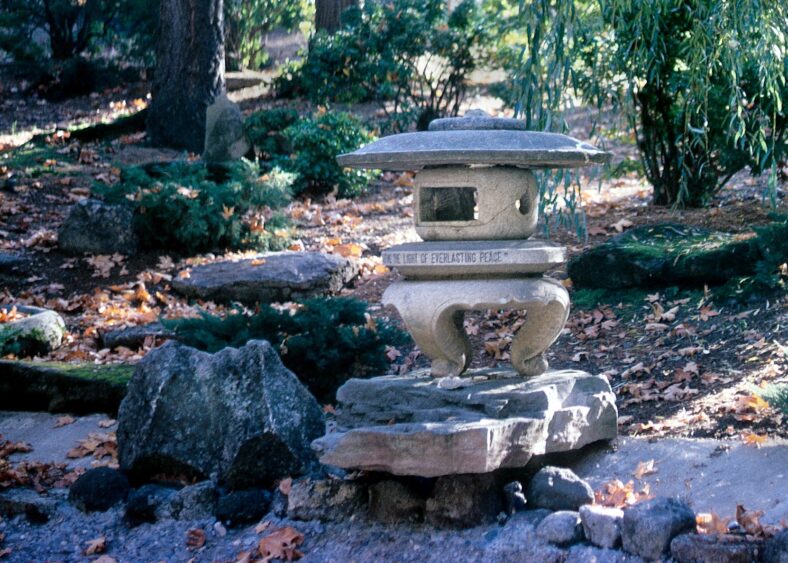
One lantern in Portland Japanese Garden invites the guest closer than any other. On the eastern bank of the Strolling Pond Garden’s upper pond, a humble yukimi doro (short stone lantern with as many as six legs) stands among evergreen shrubs, ferns, and dappled sunlight. There are no fences surrounding it and no obstacles that prevent one from sharing its space. Only three feet in height and placed on a ledge that slightly reaches out over water, it invites intimacy and regularly receives it. Garden guests who stride the step stone path to its site often will sit down and keep its company.
This particular lantern’s firebox is directly underneath a broad sloping roof, a shape that resembles a traditional Japanese hat made from rush (kasa). Moss has grown on this cover in forms that resemble continents on a map. On its body and in English, a message of hope is inscribed in capital letters: CASTING THE LIGHT OF EVERLASTING PEACE. This lantern, referred to fondly as the Peace Lantern, first took a voyage across the Pacific Ocean before finding its home in Portland Japanese Garden. This is its story.
YOKOHAMA’S MAYOR CASTS THE LIGHT OF PEACE UPON PORTLAND
In the first half of the 20th century, Portland was still ascending into the social, artistic, and economic importance it holds today. And yet, it was known in Japan, likely because many in Portland had been quite receptive to the island nation’s people and customs. A fascination and admiration for Japanese culture had blossomed in the city, with Japanese garden-themed parties being held as early as 1892, carnivals and trade shows including Japanese garden displays, and articles appearing in The Oregonian on how to build a Japanese garden for oneself.
More vitally, at the beginning of the 20th century, Issei (first generation immigrants from Japan) began to create a vibrant community in Portland named Nihonmachi, or Japantown. Confined to the blocks between the city’s northwest streets of Burnside and Broadway because of a toxic combination of racist attitudes and biased laws, they persevered and raised families, established homes, started businesses, and became civic leaders. Yet, however resilient these individuals were, they could not bear a crushing and imposed weight that would rob them of their livelihood and property: Executive Order 9066. This order signed by President Franklin D. Roosevelt after the bombing of Pearl Harbor led to the mass incarceration of innocent Japanese and Japanese Americans in concentration camps* during World War II. Nihomachi would never recover.

While the war concluded and the concentration camps released their prisoners, the lingering effects of racism still pervaded, creating a morass in which those of Japanese descent, their allies, and those who retained hatred in their heart lived as neighbors. Portland needed a light, and one came from Japan.
In the 1950s, Mayor Ryōzō Hiranuma (1951-59) of Yokohama began making gifts to different locations around the world to “cast the light” of peace. Hiranuma, sometimes referred to the “father of Japanese sports” because of his leadership of Japan’s Olympic Games delegation, would dot the United States with his city’s gestures. During Hiranuma’s tenure, Yokohama gave meaningful gifts including a granite sculpture of a Japanese pagoda that is aside Washington D.C.’s Tidal Basin, a stone lantern that rests outside the entrance of Honolulu’s City Hall, and a Japanese Friendship Bell that was placed on San Diego’s Shelter Island.
Another recipient of Yokohama’s outreach would be Portland. While the tragedies of the World War II era interrupted the burgeoning friendship of the United States and Japan and the undercurrent of bigotry hadn’t been vanquished, there remained a strong group of leaders in both Portland and Japan who believed American-Japanese connections were worth resuscitating and were undaunted by an often hostile climate.
Thus, Mayor Hiranuma found kindred spirits in Portland who were eager to repair ties and move forward together. Portland Mayor Fred Peterson (1953-57) had visited Seattle and had seen a stone lantern in one of the city’s parks. This motivated Mayor Peterson to reach out to his counterpart in Yokohama in hopes Portland could have one as well. Mayor Hiranuma, familiar with Stumptown because of his visit there for the 1953 Japanese-American Pacific Coast Mayors’ Conference, would respond with a gracious letter in which he agreed to send one to Oregon’s largest city:
“Now in Japan, the international interchange of culture is earnestly advocated and I feel it is a very good trend as Japan has announced after the war that she would restart to be a cultural nation. From the above viewpoint, it is very significant that Yokohama people [would] send one of… Japan’s traditional garden decorations to the city of Portland.”
In 1954, the lantern made way for Portland, conveyed on a ship that would be among the first Japanese vessels to arrive in the area since World War II, with the available information suggesting it could have been the Hikawa Maru, an ocean liner operated by the Japanese shipping company, Nippon Yūsen Kabushiki Kaisha. There may have been no more fitting vessel to send this message of peace than the Hikawa Maru. Before Japan entered World War II, she had ferried passengers and cargo back and forth between Seattle and Japan. Now a floating museum in Yokohama and designated as an “Important Cultural Property” by Japan’s government, it was also the means of escape for Jewish refugees who fled to Japan from Nazi-occupied Lithuania and sought safe harbor in North America. After a stint as a hospital ship during World War II, it resumed its peaceful voyages on the sea.
THE PEACE LANTERN ARRIVES TO ITS PORTLAND HOME
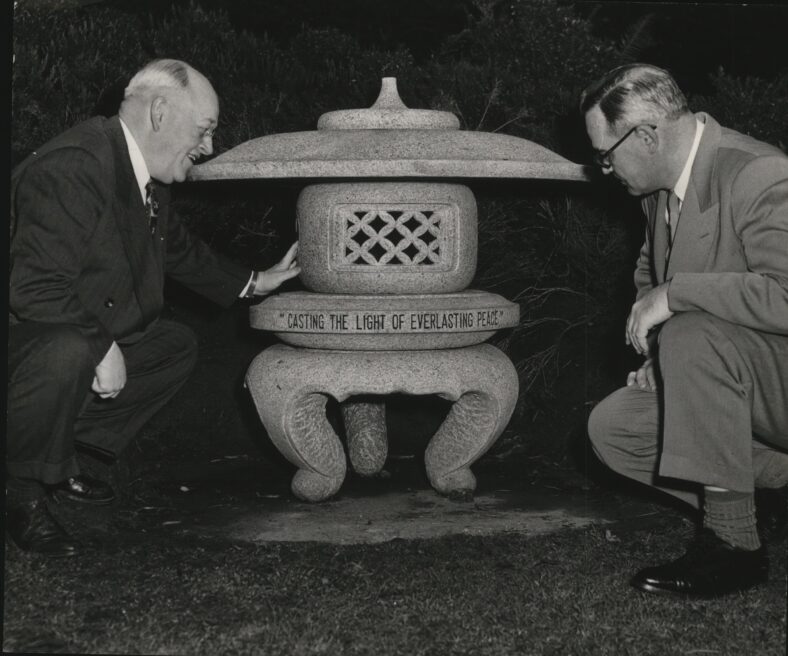
rights reserved. Used with permission.
The Peace Lantern’s first point of entry would be in Seattle, where it was held for inspection by customs officials. The delay this caused in its departure for Oregon forced Portland to hold a “figurative” presentation of the lantern in November of 1954. Joining Mayor Peterson in this ceremony was His Excellency, Japan’s Ambassador to the United States, Sadao Iguchi (1954-56). Ambassador Iguchi would share a letter from Mayor Hiranuma, who shared that he hoped “that the stone lantern will serve in the future as a cornerstone on which everlasting friendship and amity between the United States of America and Japan will be firmly built up.” Mayor Peterson shared a similar sentiment, voicing his hope that the lantern would symbolize that the U.S. and Japan “can continue in peace, happiness, and mutual progress.”
When the Peace Lantern finally arrived to Portland in 1955, its first home would be in the International Rose Test Garden in Washington Park. A photograph taken at its unveiling shows Mayor Peterson smiling as he pats its firebox. Joining him is longtime Commissioner Stanley W. Earl (1953-70), who appears to be reading the inscription.
There may have been no more fitting person to help receive the lantern than Commissioner Earl. Shortly after his death in 1970, a letter to The Oregonian noted Earl had passionately advocated for Japanese-Americans after the attack on Pearl Harbor. Undeterred by an unruly group of workers who were contributing to the anti-Japanese agitation, he was reported to have climbed atop a pile of lumber on top of a dock at the Portland waterfront and bellowed:
“I am ashamed of you! What kind of Americans are you who would turn against your fellow workers because they came from a people whose present leaders launched an attack on our nation? All of us came from nations for whose politics and leaders we have no responsibility…The least you can do as good union men and as good Americans is to stand by them when they need us. I appeal to all of our Japanese-American brothers to stay on the job, and I appeal to you to help them through these difficult days.”
Yet, however desiring for reconciliation the Japanese-American community and their allies in civic leadership may have been, bigotry continued to run rampant and its targets would include the Peace Lantern in its Rose Garden home. Today one can still see the scars and deformities forced upon the lantern by vandals for whom the light of peace could not reach. Its hoju (finial top) has been lopped off and its roof is now dog-eared from repeated toppling. Long cracks along its firebox resemble a grimace.
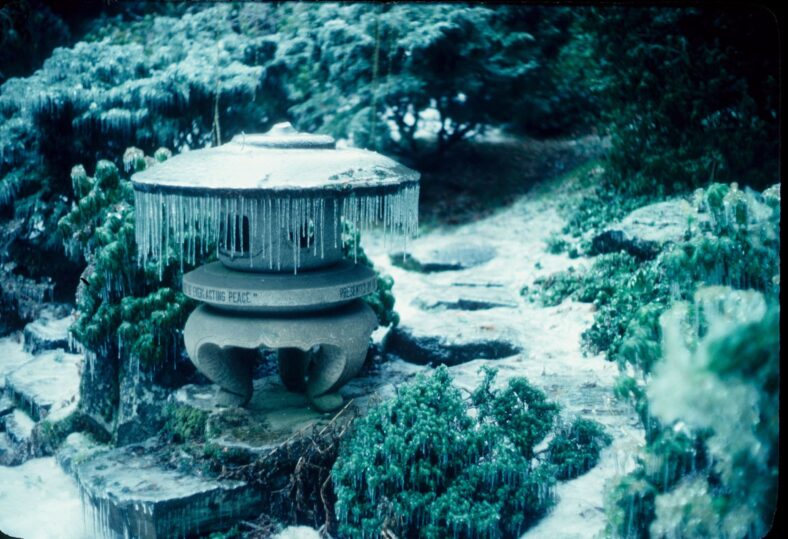
Finally, in 1966, one year before Portland Japanese Garden opened to the public, the lantern was moved to a bank of the upper pond in its Strolling Pond Garden, where it has remained to this day. The Strolling Pond Garden, reflecting a landscape style that was popularized during Japan’s Edo period (1603-1868), is a fitting location for the Peace Lantern, itself stylized in the yukimi doro form believed to have become popularized during the same era. Typically placed near water, they illuminated land so boats wouldn’t run ashore. The yukimi doro is also often referred to as a snow-viewing lantern—when snow adorns its roof, it creates a pleasant reflection in water.
It would be more than satisfying to report that the Peace Lantern had finally found safe harbor – that the tragedies that inspired Yokohama’s gift had been vanquished and that as Portland Japanese Garden prepared to open its gates, the light of peace had finally been cast on its host city. Sadly, this was not so. Nearly twenty years after the end of World War II, animosity still had too many within its throes and they unleashed their burdens on the Garden.
A COMMUNITY TRANSFORMED
It can be a struggle to imagine that Portland Japanese Garden, a serene public space that has welcomed nearly half a million visitors per year from every U.S. state and more than 90 nations, was ever a site of turmoil, but it was. As it was built during the 1960s, picketers would gather outside the Garden, waving signs with racist pejoratives. Stones would be hurled at its Japanese employees. Graffiti was sprayed and structures were damaged. Portland Japanese Garden’s first Garden Director, Kinya Hira (1964-69), would be ripped from his on-site trailer and stabbed in a premeditated assault.
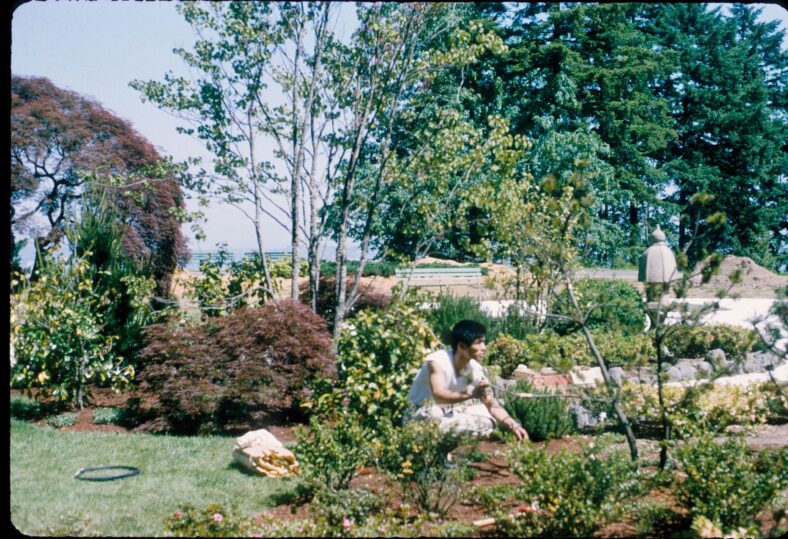
Still, there were enough people, Japanese, American, and beyond, who refused to be deterred. These early leaders carried on and in 1967, Portland Japanese Garden opened. There exists no earthly ledger that can tally the hearts of a people and no calendar date to declare as the day the tides finally turned. All we know is that conditions have improved, perceptions of Japan have warmed, that Portland Japanese Garden played a part and that it will continue the work its first stewards initiated.
The change in attitude is likely a result, in part, from Portland Japanese Garden exploring and exporting the awesome power of cultural diplomacy. The organization’s programming is presented in a manner that requires no translation or previous knowledge of Japan, an intentional effort to make a culture that can seem impossibly foreign to a Western audience more accessible. All of this diplomacy, be it in the form of festival celebrations, art exhibitions, or cultural demonstrations, all have taken their lead from the land.
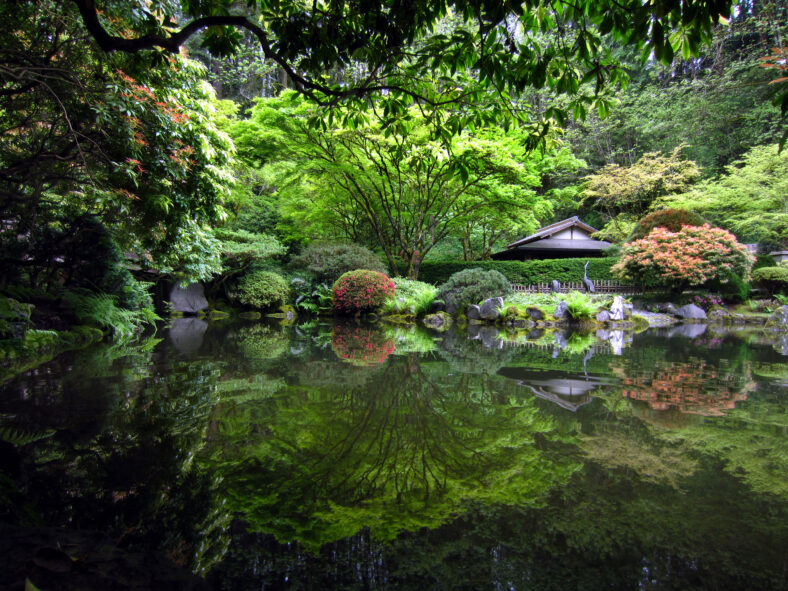
“Japanese and American cities started to develop sister-city friendships primarily after World War II and in so many American cities it resulted in a garden,” shares Sadafumi Uchiyama, Garden Director from 2008 to 2021 and Chief Curator from 2021 to 2023. “Why gardens? They might have constructed buildings or erected monuments, but instead the relationship was often celebrated with the establishment of a garden. I think it’s because gardens lack strict definition and don’t prescribe use. This led people like Portland’s civic leaders to build gardens intuitively – a garden belongs to no one but everyone. All are welcome in nature.”
As Portland Japanese Garden grew in visitation, in membership, in its number of staff and volunteers, and in its stature as a global thought leader, the Peace Lantern has remained a stabilizing presence as history unfolded around it. This could be where its story concludes, but it does not. The Peace Lantern’s travels concluded more than 50 years ago, but its significance has not waned. Rather, it has inspired the generations that followed.
GIFTING LANTERNS ACROSS THE WORLD

After several decades and visits from millions of guests, the Peace Lantern would bond Portland and Yokohama once again. In 2017, Yokohama was preparing for Japan’s Annual National Urban Greenery Fair, a large national festival that recognizes the importance of nature. As Yokohama readied itself for this high-profile event, Portland Japanese Garden’s Chief Curator, Sadafumi Uchiyama, was approached by his sensei, landscape architecture expert Professor Isoya Shinji, one of the people tasked with preparing the city.
“Professor Shinji did not want just flowers in a garden for the Urban Greenery Fair,” Uchiyama said. “He was looking for a symbol; something tangible. He believed that a landscape has everything to do with human culture and the acknowledgement of history. Over dinner one night I mentioned, ‘We have our stone lantern from Yokohama,’ and that was it. That is how it started.”
Shinji and Uchiyama agreed a replica of the Peace Lantern would be a fitting element for the occasion. After receiving approval from Mayor Fumiko Hayashi (2009-21), Yokohama sent stone masons Tetsuro Tanabe and Hideo Araki to Portland Japanese Garden to get precise measurements of the Peace Lantern. The two experts would then make an identical replica back in Japan. While they worked, city leaders determined this new Peace Lantern’s future home. “They chose to place it in a small but old Japanese garden called Higa-en in Yokohama, right next to the baseball stadium,” Uchiyama recalled.
On March 25th, the Peace Lantern was revealed to the delight of Yokohama residents. This endeavor would showcase how cultural diplomacy is reciprocal—that those who dare to embark upon it can wind up not only fostering friendship, but also help fortify their own traditions and customs. Aki Nakanishi, the Arlene Schnitzer Curator of Culture, Art, and Education of Portland Japanese Garden has noted that the crafting of new stone lanterns in Japan has slowed measurably compared to the centuries of past millennia. By retaining the talents of stone masons for an impactful gift, the Garden has helped support a traditional artform. “An American organization is raising funds to help assist and steward design integral to Japanese culture,” Nakanishi shared. “We’re helping nurture this homegrown craftsmanship so the rest of the world can continue to enjoy it.”
Spurred on by this initial success, Portland Japanese Garden and its global cultural initiative and sibling organization, Japan Institute, have donated handcrafted replicas of the Peace Lantern around the world. The Garden would present a lantern to Sapporo in 2019, a fitting gesture borne out of a long-lasting sister-city friendship established by the Japanese municipality and Portland in 1959.
In 2020, the Garden had planned to continue their donation of Peace Lanterns, this time to the cities of Hiroshima and Nagasaki in recognition of the 75th anniversary of the conclusion of World War II. Unfortunately, the global pandemic forced these plans to be paused. As the world began to make its return to normalcy, however, the donations of lanterns became a duty assigned to the Garden’s new sibling organization, Japan Institute.
In 2022, Japan Institute would finally be able to act on the Garden’s intention and donated lanterns to Hiroshima and Nagasaki, both of which have overcome ruin to become world leaders in spreading the message of peace. In Hiroshima, the Peace Lantern has been placed on a green belt that runs parallel to the city’s Peace Memorial Park. In Nagasaki, the Peace Lantern resides in a space where millions of visitors pass by on their way to the Nagasaki Atomic Bomb Museum. Additionally, the organization would contribute a handcrafted replica to Tokyo ahead of its inaugural Peace Symposium there, a fitting location as Japan’s capital had dotted the globe with gifts of peace just as Yokohama did. Japan Institute would cap 2022 off with the presentation of one more lantern to a major global city, but for the first time, one outside of Japan. In recognition of a mutual desire to foster long-lasting peace through nature, Japan Institute would gift a Peace Lantern to the Japanese Landscape of the Royal Botanic Gardens, Kew in London, England.
INSPIRING HARMONY AND PEACE
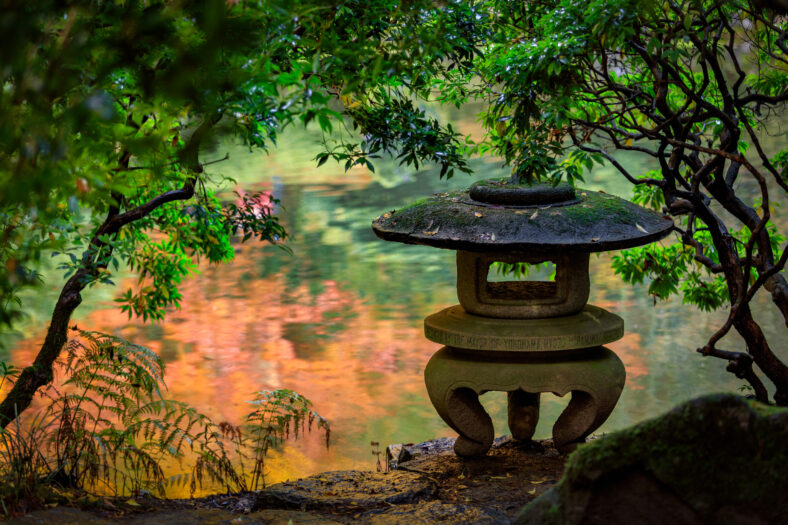
Portland Japanese Garden was founded 60 years ago on the belief that friendship between the United States and Japan could be renewed after the tragedies of World War II. Able to envision a harmonious future where nature could be a setting for cultural exchange that leads to long lasting peace, a band of Portland civic leaders were undeterred by a vocal and violent opposition to transform the barren remains of an old zoo into a verdant oasis, a jewel in Portland’s West Hills. Portland Japanese Garden’s highly articulated vision of nature’s beauty exists because of the touch of the human hand, its magnetism as a nexus and haven for people to gather in friendship exists because of the resiliency of the human heart. The Garden’s care and maintenance have now been stewarded by a community of successive generations all imbued with the organization’s mission: Inspiring Harmony and Peace.
There is no more fitting symbol of Portland Japanese Garden’s journey and mission than its Peace Lantern. The message inscribed in the lantern’s salt and pepper granite reads as clearly as the day it arrived: CASTING THE LIGHT OF EVERLASTING PEACE. Like our mission, Mayor Hiranuma’s words are written with an active voice. This reminds us that Portland Japanese Garden and the Peace Lantern are not relics of our forebearers, they are beacons that a community keep illuminated. Short in stature, the Peace Lantern casts a light that reaches across land and ocean to reveal that the path to harmony and peace, both inner and between people, can be taken through the Garden.
Written by Will Lerner, Communications Specialist
*Language Matters: There is no universal agreement on what we call the camps or the process that created them — ‘incarceration,’ ‘internment,’ and ‘concentration’ are a few of the terms that were interchangeably used. While some might find ‘concentration’ misleading because these were not extermination camps, the term predates the Holocaust and is by definition a place where large numbers of people are detained or confined under armed guard. We believe that awareness of the historical import of these words, as well as care in using them, is an important way to respect the collective memory of the victims and grants us greater power to confront injustice and cultivate peace.
“A concentration camp is a place where people are imprisoned, not because of the crimes they committed, but simply because of who they are. During World War II, America’s concentration camps were clearly distinguishable from Nazi Germany’s. Despite the difference, all had one thing in common: that people in power removed a minority group from the general population and the rest of society let it happen.” – Joint Statement by Japanese-American National Museum and the American Gathering of Jewish Holocaust Survivors at the 1994 exhibition, America’s Concentration Camps: Remembering the Japanese American Experience
